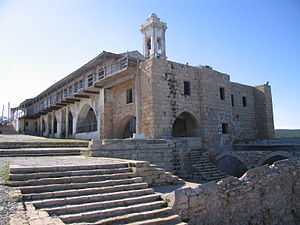Apostolos Andreas Monastery
| Apostolos Andreas Greek: Απόστολος Ανδρέας | |
|---|---|
 | |
 Apostolos Andreas Monastery | |
| Basic information | |
| Location | Karpass Peninsula, Cape Apostolos Andreas |
| Geographic coordinates | 35°41′41″N 34°35′08″E / 35.69466°N 34.58556°ECoordinates: 35°41′41″N 34°35′08″E / 35.69466°N 34.58556°E |
| Affiliation | Greek Orthodox, Christianity |
| District | Famagusta District |
| Architectural description | |
Apostolos Andreas Monastery (Turkish: Apostolos Andreas Manastırı; Greek: Απόστολος Ανδρέας) is a monastery situated just south of Cape Apostolos Andreas, the north-easternmost point of the island of Cyprus, in Rizokarpaso in the Karpass Peninsula. The monastery is dedicated to Saint Andrew and is an important site for the Cypriot Orthodox Church. It was once known as 'the Lourdes of Cyprus', served not by an organized community of monks but by a changing group of volunteer priests and laymen. Both Greek Cypriot and Turkish Cypriot communities consider the monastery a holy place. As such it is visited by many people for votive prayers. The contents of the monastery are also noteworthy.
History
The traditional story of the monastery's founding says that, during a journey to the Holy Land, the ship transporting Saint Andrew went off course and struck rocks here. On coming ashore, Andrew hit the rocks with his staff, at which point a spring gushed forth. The waters proved to have healing powers and restored the sight of the ship's captain who had been blind in one eye. Thereafter, the site became a place of pilgrimage. A fortified monastery stood here in the 12th century, from which Isaac Comnenus negotiated his surrender to Richard the Lionheart. In the 15th century, a small chapel was built close to the shore. The church of the main monastery dates to the 18th century, while the main buildings are 100 years later.[1]
Mass pilgrimage, however, is only comparatively recent, dating back to the 20th century. The story is told that in 1895 the son of Maria Georgiou was kidnapped. Seventeen years later, Saint Andrew appeared to her in a dream, telling her to pray for her son's return at the monastery. Living in Anatolia, she embarked on the crossing to Cyprus on a very crowded boat. Telling her story during the journey, one of the passengers, a young Dervish priest became more and more interested. Asking if her son had any distinguishing marks, and on hearing of a pair of birthmarks, he stripped off his clothes to reveal the same marks, and mother and son were reunited.[1]
After the Turkish Invasion of Cyprus in 1974, most of the Greek Cypriots in the area were forced to leave their houses, although a few remained in Rizokarpaso. For the next 30 years very few pilgrims visited the monastery, but with the opening of crossing points the flow is now increasing. The monastery has fallen into a state of disrepair in recent years, UN funding is in place to pay for refurbishment, along with the Hala Sultan Tekke near Larnaca.[1]
Restoration
A bi-communal technical committee was created in 2008 to be responsible for protecting the island’s cultural heritage. The committee has been coordinating Apostolos Andreas’ restoration efforts for the past year. The Church of Cyprus refused to co-operate because a document prepared by the United Nations Development Programme did not name it as the owner of the monastery, but merely donors, with Archbishop Chrysostomos II saying he was willing to let the historic monastery collapse rather than sign up to a plan that did not recognize the Church of Cyprus as the owner.[2]
On 12 January 2013, Turkish Republic of Northern Cyprus authorities stated that the monastery will undergo extensive restoration costing more than 5 million Euros.[3] The restoration work will be conducted by an international team of experts and be solely funded by the Government of the Turkish Republic of Northern Cyprus.
References
- ↑ 1.0 1.1 1.2 Apostolos Andreas Monastery, Karpaz, North Cyprus
- ↑ LGC News, The Online Newspaper for North Cyprus. ""We are not donors – we are owners": says Archbishop". Retrieved 13 January 2013.
- ↑ 'Türkler onaracağına yıkılsın gitsin' - Hürriyet PLANET
External links
 Media related to Apostolos Andreas Monastery at Wikimedia Commons
Media related to Apostolos Andreas Monastery at Wikimedia Commons
| ||||||